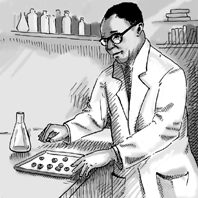Library Resource Kit
Who Was Percy Julian?
Expanded Version
Dr. Percy Lavon Julian was a trailblazing chemist whose discoveries improved
and saved countless lives. The grandson of slaves, Julian grew up at a time
when African Americans faced extraordinary obstacles. Yet Julian refused to let
racism prevent him from becoming one of the most influential scientists of the
20th century, as well as a leader in business and civil rights.
Julian was born in Montgomery, Alabama, on April 11, 1899. Both of his parents
were educated, which was rare for Black families in the South at that time.
Although his family greatly valued education, Julian had to attend a segregated
elementary school. And, because Montgomery had no public high school for
African Americans, he was forced to attend a teacher training school for
African Americans instead.
In 1916, having barely a tenth-grade education, Julian entered DePauw
University, a largely white liberal arts school in Indiana. "On my first day in
college," he recalled, "I remember walking in and a white fellow stuck out his
hand and said, 'How are you? Welcome!' I had never shaken hands with a white
boy before and did not know whether I should or not." Despite having to take
remedial courses to catch up to his white peers and experiencing considerable
racial discrimination, Julian not only earned a bachelor's degree in chemistry,
he graduated Phi Beta Kappa and first in his class.
After teaching chemistry at Fisk University for a couple of years, Julian won a
fellowship to continue his graduate work. In 1923, he became the first African
American to earn a master's degree in chemistry from Harvard University.
However, Harvard still refused him admission to its doctoral
program—Julian had been denied the teaching assistantship needed for
admission. Julian eventually became the head of the chemistry department at
Howard University, an African American institution. Determined to continue his
education, he enrolled in the University of Vienna, and in 1931 he earned a
Ph.D. in chemistry, the fourth African American to achieve this distinction. It
was in Vienna that he experienced a new sense of freedom—accessing layers
of society unavailable in the United States. It was here that Julian also began
his lifelong inquiry into the chemistry of plants.
Returning to DePauw University as a research fellow, Julian eventually became
an expert in synthesis, the process of turning one substance into another
through a series of planned chemical reactions. Synthesis was the highest
calling for a chemist in the 1930s. In 1935, Julian and a colleague synthesized
physostigmine, a plant compound from Calabar beans, and won a high-stakes,
high-profile scientific victory over the "dean" of chemistry, Sir Robert
Robinson. Their achievement led to physostigmine being widely used as a
treatment for glaucoma. In fact, in 1999, the American Chemical Society
recognized their work as a National Historic Chemical Landmark—one of the
top 25 accomplishments in American chemical history. In addition, numerous
undergraduates trained by Julian were published in the Journal
of
the American Chemical Society—an unheard of occurrence at the time.
Still, despite his impressive achievements, Julian's opportunities were sharply
restricted, and
DePauw
refused to appoint him to a permanent faculty position. American colleges and
universities at the time simply were not prepared to have a Black person
teaching white students. Thus, Julian moved from the world of academia to the
world of business, where although he faced similar challenges, he landed a job
as Director of Research at the Glidden Company in 1936.
Among other important achievements, Julian's highly successful research at
Glidden helped trigger an explosive growth industry for soybeans. For 18 years,
his work uncovering new uses for the chemicals found in soybeans was not only
enormously profitable for Glidden, it helped relieve human suffering across the
globe. For example, a protein he extracted from soybeans was used to produce a
fire-retardant foam in fire extinguishers. Called Aer-o-foam, it saved
thousands of soldiers' lives during World War II.
In addition, Julian discovered a process for making artificial hormones. The
discovery was actually serendipitous: after water leaked into a giant tank of
soybean oil, Julian recognized crystals of stigmasterol, a steroid, at the
bottom of the tank. He eventually developed a process for converting
stigmasterol into progesterone and making it available on a commercial scale.
Today progesterone is used to decrease the risk for uterine cancer and in
hormone replacement therapy. Julian also found a way to create synthetic
cortisone, making this once prohibitively expensive "wonder drug" affordable to
millions of arthritis sufferers.
In recognition of his contributions to society, Julian was named Chicagoan of
the Year in 1950. But when he and his wife Anna and their two children moved to
Oak Park, Illinois, a predominantly white, affluent suburb of Chicago, they
encountered violent resistance. Despite attempts to intimidate them—their
house was set on fire and firebombed—the Julians stood their ground and
remained in Oak Park.
In 1953, Julian established Julian Laboratories to produce synthetic steroids,
which pharmaceutical companies used to make drugs. He proved to be as talented
an entrepreneur as he was a chemist. Julian's company flourished, making him a
millionaire when he sold it in 1961. By the 1970s, Julian had more than 100
patents to his name and was widely recognized as an innovator who had helped
make a range of medicines more affordable. He also was a prominent civic and
civil rights leader, raising funds and speaking publicly for racial justice and
full equality for all Americans. Perhaps his greatest contribution was breaking
the color barrier in American industrial science: Julian's labs were the
training grounds for dozens of promising young African American chemists. For
his contributions to humanity, Julian received 18 honorary degrees and more
than a dozen civic and scientific awards; he was the second African American
elected to the National Academy of Sciences and the first chemist.
Percy Julian died of liver cancer in 1975, at the age of 76. Throughout the
world, millions of people continue to benefit from his groundbreaking
discoveries.


